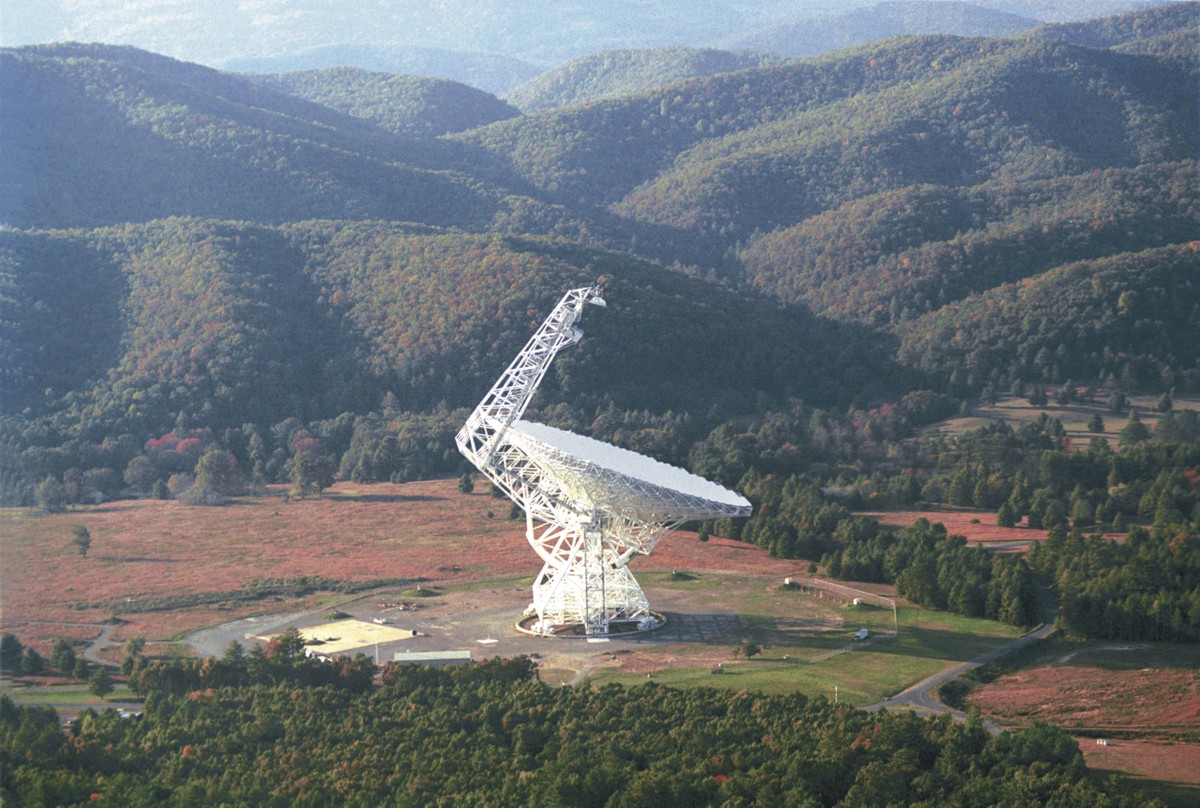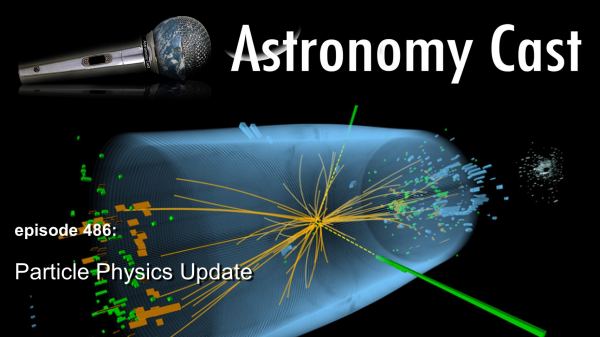As we continue to search for dark matter particles, one thing is very clear: they cannot be any of the elementary particles we’ve discovered so far. The particles would need to have mass, but interact with light only weakly. Of the known particles, neutrinos fit that description, but neutrinos have a tiny mass, and aren’t nearly enough to explain dark matter. Some other kind of particle must make up the majority of dark matter.
Continue reading “If Axions Explain Dark Matter, it Could be Possible to Detect Them Nearby Neutron Stars”A Fifth Fundamental Force Could Really Exist, But We Haven’t Found It Yet
The universe is governed by four fundamental forces: gravity, electromagnetism, and the strong and weak nuclear forces. These forces drive the motion and behavior of everything we see around us. At least that’s what we think. But over the past several years there’s been increasing evidence of a fifth fundamental force. New research hasn’t discovered this fifth force, but it does show that we still don’t fully understand these cosmic forces.
Continue reading “A Fifth Fundamental Force Could Really Exist, But We Haven’t Found It Yet”Astronomy Cast Ep. 486: Particle Physics Update
It’s time for a news update. This time from the field of particle physics. It turns out there have been all kinds of new and interesting particles discovered by the Large Hadron Collider and others. Let’s get an update from Pamela.
We usually record Astronomy Cast every Friday at 3:00 pm EST / 12:00 pm PST / 20:00 PM UTC. You can watch us live on AstronomyCast.com, or the AstronomyCast YouTube page.
Visit the Astronomy Cast Page to subscribe to the audio podcast!
If you would like to support Astronomy Cast, please visit our page at Patreon here – https://www.patreon.com/astronomycast. We greatly appreciate your support!
If you would like to join the Weekly Space Hangout Crew, visit their site here and sign up. They’re a great team who can help you join our online discussions!
Astronomy Cast Ep. 392: The Standard Model – Intro
Humans, cars and planets are made of molecules. And molecules are made of atoms. Atoms are made of protons, neutrons and electrons. What are they made of? This is the standard model of particle physics, which explains how everything is put together and the forces that mediate all those particles.
Continue reading “Astronomy Cast Ep. 392: The Standard Model – Intro”
A Universe of 10 Dimensions

When someone mentions “different dimensions,” we tend to think of things like parallel universes – alternate realities that exist parallel to our own but where things work differently. However, the reality of dimensions and how they play a role in the ordering of our Universe is really quite different from this popular characterization.
To break it down, dimensions are simply the different facets of what we perceive to be reality. We are immediately aware of the three dimensions that surround us – those that define the length, width, and depth of all objects in our universes (the x, y, and z axes, respectively).
Beyond these three visible dimensions, scientists believe that there may be many more. In fact, the theoretical framework of Superstring Theory posits that the Universe exists in ten different dimensions. These different aspects govern the Universe, the fundamental forces of nature, and all the elementary particles contained within.
The first dimension, as already noted, is that which gives it length (aka. the x-axis). A good description of a one-dimensional object is a straight line, which exists only in terms of length and has no other discernible qualities. Add to that a second dimension, the y-axis (or height), and you get an object that becomes a 2-dimensional shape (like a square).
The third dimension involves depth (the z-axis) and gives all objects a sense of area and a cross-section. The perfect example of this is a cube, which exists in three dimensions and has a length, width, depth, and hence volume. Beyond these three dimensions reside the seven that are not immediately apparent to us but can still be perceived as having a direct effect on the Universe and reality as we know it.
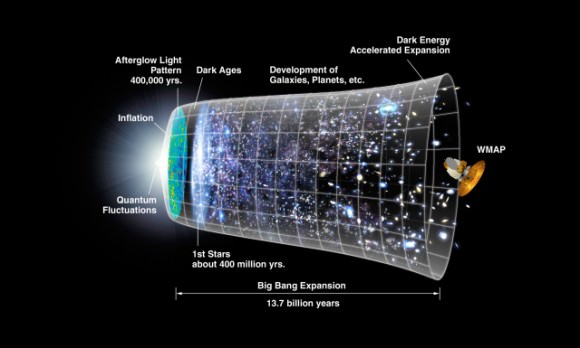
Scientists believe that the fourth dimension is time, which governs the properties of all known matter at any given point. Along with the three other dimensions, knowing an object’s position in time is essential to plotting its position in the Universe. The other dimensions are where the deeper possibilities come into play, and explaining their interaction with the others is where things get particularly tricky for physicists.
According to Superstring Theory, the fifth and sixth dimensions are where the notion of possible worlds arises. If we could see on through to the fifth dimension, we would see a world slightly different from our own, giving us a means of measuring the similarity and differences between our world and other possible ones.
In the sixth, we would see a plane of possible worlds, where we could compare and position all the possible universes that start with the same initial conditions as this one (i.e., the Big Bang). In theory, if you could master the fifth and sixth dimensions, you could travel back in time or go to different futures.
In the seventh dimension, you have access to the possible worlds that start with different initial conditions. Whereas in the fifth and sixth, the initial conditions were the same, and subsequent actions were different, everything is different from the very beginning of time. The eighth dimension again gives us a plane of such possible universe histories. Each begins with different initial conditions and branches out infinitely (hence why they are called infinities).
In the ninth dimension, we can compare all the possible universe histories, starting with all the different possible laws of physics and initial conditions. In the tenth and final dimension, we arrive at the point where everything possible and imaginable is covered. Beyond this, nothing can be imagined by us lowly mortals, which makes it the natural limitation of what we can conceive in terms of dimensions.
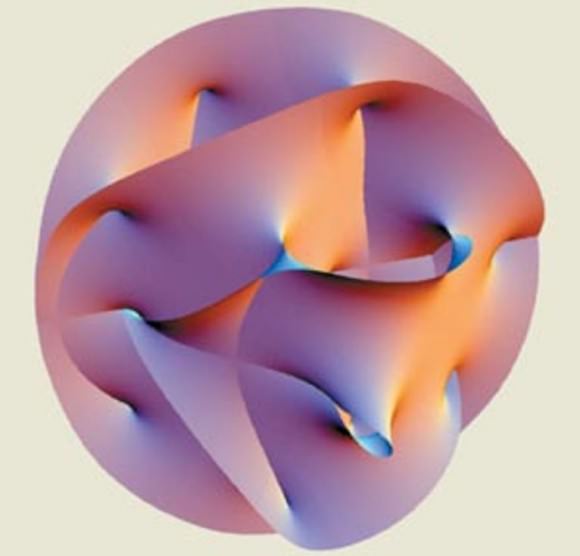
The existence of these additional six dimensions, which we cannot perceive, is necessary for String Theory for there to be consistency in nature. The fact that we can perceive only four dimensions of space can be explained by one of two mechanisms: either the extra dimensions are compactified on a very small scale, or else our world may live on a 3-dimensional submanifold corresponding to a brane, on which all known particles besides gravity would be restricted (aka. brane theory).
If the extra dimensions are compactified, then the extra six dimensions must be in the form of a Calabi–Yau manifold (shown above). While imperceptible as far as our senses are concerned, they would have governed the formation of the Universe from the very beginning. Hence why scientists believe that by peering back through time and using telescopes to observe light from the early Universe (i.e., billions of years ago), they might be able to see how the existence of these additional dimensions could have influenced the evolution of the cosmos.
Much like other candidates for a grand unifying theory – aka the Theory of Everything (TOE) – the belief that the Universe is made up of ten dimensions (or more, depending on which model of string theory you use) is an attempt to reconcile the standard model of particle physics with the existence of gravity. In short, it is an attempt to explain how all known forces within our Universe interact and how other possible universes themselves might work.
For additional information, here’s an article on Universe Today about parallel Universes and another on a parallel Universe that scientists thought they’d found, but doesn’t actually exist.
There are also some other great resources online. There is a great video that explains the ten dimensions in detail. You can also look at the PBS website for the TV show Elegant Universe. It has a great page on the ten dimensions.
You can also listen to Astronomy Cast. You might find Episode 137: Large Scale Structure of the Universe very interesting.
Source: PBS
BICEP2 All Over Again? Researchers Place Higgs Boson Discovery in Doubt
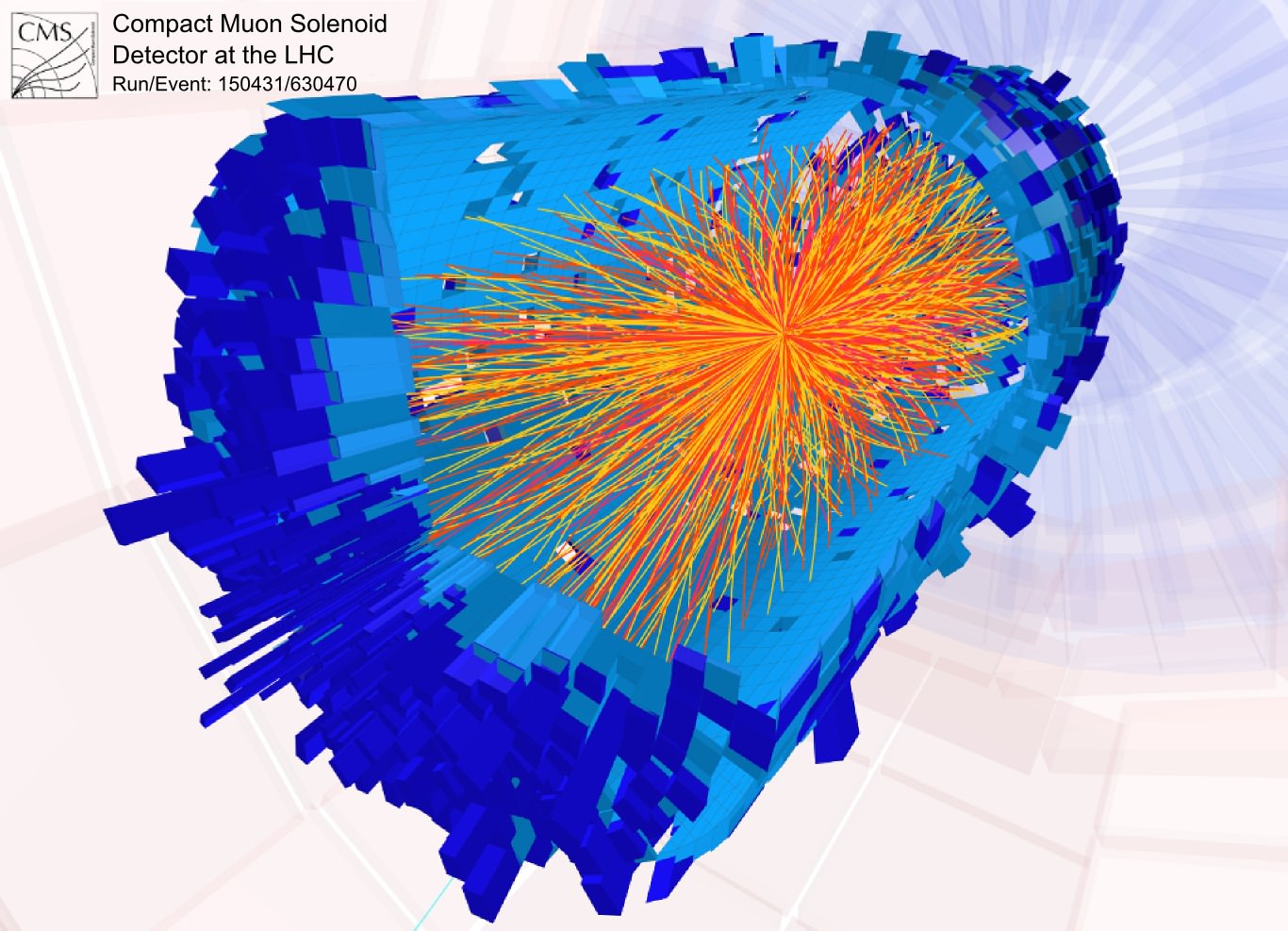
At the Large Hadron Collider (LHC) in Europe, faster is better. Faster means more powerful particle collisions and looking deeper into the makeup of matter. However, other researchers are proclaiming not so fast. LHC may not have discovered the Higgs Boson, the boson that imparts mass to everything, the god particle as some have called it. While the Higgs Boson discovery in 2012 culminated with the awarding in December 2013 of the Nobel Prize to Peter Higgs and François Englert, a team of researchers has raised these doubts about the Higgs Boson in their paper published in the journal Physical Review D.
The discourse is similar to what unfolded in the last year with the detection of light from the beginning of time that signified the Inflation epoch of the Universe. Researchers looking into the depths of the Universe and the inner depths of subatomic particles are searching for signals at the edge of detectability, just above the noise level and in proximity to the signals from other sources. For the BICEP2 telescope observations (previous U.T. articles), its pretty much back to the drawing board but the Higgs Boson (previous U.T. articles) doubts are definitely challenging but needing more solid evidence. In human affairs, if the Higgs Boson was not detected by the LHC, what does one do with an awarded Nobel Prize?
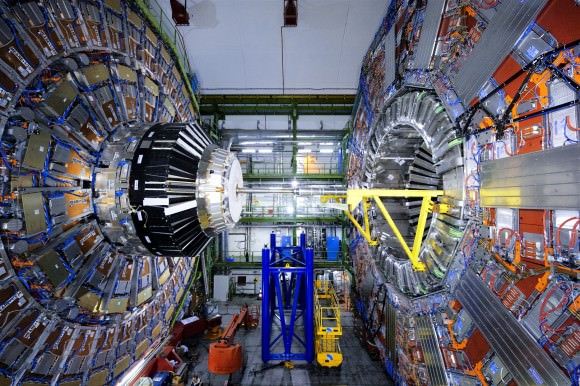
The present challenge to the Higgs Boson is not new and is not just a problem of detectability and acuity of the sensors as is the case with BICEP2 data. The Planck space telescope revealed that light radiated from dust combined with the magnetic field in our Milky Way galaxy could explain the signal detected by BICEP2 that researchers proclaimed as the primordial signature of the Inflation period. The Higgs Boson particle is actually a prediction of the theory proposed by Peter Higgs and several others beginning in the early 1960s. It is a predicted particle from gauge theory developed by Higgs, Englert and others, at the heart of the Standard Model.
This recent paper is from a team of researchers from Denmark, Belgium and the United Kingdom led by Dr. Mads Toudal Frandsen. Their study entitled, “Technicolor Higgs boson in the light of LHC data” discusses how their supported theory predicts Technicolor quarks through a range of energies detectable at LHC and that one in particular is within the uncertainty level of the data point declared to be the Higgs Boson. There are variants of Technicolor Theory (TC) and the research paper compares in detail the field theory behind the Standard Model Higgs and the TC Higgs (their version of the Higgs boson). Their conclusion is that a TC Higgs is predicted by Technicolor Theory that is consistent with expected physical properties, is low mass and has an energy level – 125 GeV – indistinguishable from the resonance now considered to be the Standard Model Higgs. Theirs is a composite particle and it does not impart mass upon everything.
So you say – hold on! What is a Technicolor in jargon of particle physics? To answer this you would want to talk to a plumber from South Bronx, New York – Dr. Leonard Susskind. Though no longer a plumber, Susskind first proposed Technicolor to describe the breaking of symmetry in gauge theories that are part of the Standard Model. Susskind and other physicists from the 1970s considered it unsatisfactory that many arbitrary parameters were needed to complete the Gauge theory used in the Standard Model (involving the Higgs Scalar and Higgs Field). The parameters consequently defined the mass of elementary particles and other properties. These parameters were being assigned and not calculated and that was not acceptable to Susskind, ‘t Hooft, Veltmann and others. The solution involved the concept of Technicolor which provided a “natural” means of describing the breakdown of symmetry in the gauge theories that makeup the Standard Model.
Technicolor in particle physics shares one simple thing in common with Technicolor that dominated the early color film industry – the term composite in creating color or particles.

If the theory surrounding Technicolor is correct, then there should be many techni-quark and techni-Higgs particles to be found with the LHC or a more powerful next generation accelerator; a veritable zoo of particles besides just the Higgs Boson. The theory also means that these ‘elementary’ particles are composites of smaller particles and that another force of nature would be needed to bind them. And this new paper by Belyaev, Brown, Froadi and Frandsen claims that one specific techni-quark particle has a resonance (detection point) that is within the uncertainty of measurements for the Higgs Boson. In other words, the Higgs Boson might not be “the god particle” but rather a Technicolor Quark particle comprised of smaller more fundamental particles and another force binding them.
This paper by Belyaev, Brown, Froadi and Frandsen is a clear reminder that the Standard Model is unsettled and that even the discovery of the Higgs Boson is not 100% certain. In the last year, more sensitive sensors have been integrated into CERN’s LHC which will help refute this challenge to Higgs theory – Higgs Scalar and Field, the Higgs Boson or may reveal the signatures of Technicolor particles. Better detectors may resolve the difference between the energy level of the Technicolor quark and the Higgs Boson. LHC researchers were quick to state that their work moves on beyond discovery of the Higgs Boson. Also, their work could actually disprove that they found the Higgs Boson.
Contacting the co-investigator Dr. Alexander Belyaev, the question was raised – will the recent upgrades to CERN accelerator provide the precision needed to differentiate a technie-Quark from the Higg’s particle?
“There is no guarantee of course” Dr. Belyaev responded to Universe Today, “but upgrade of LHC will definitely provide much better potential to discover other particles associated with theory of Technicolor, such as heavy Techni-mesons or Techni-baryons.”
Resolving the doubts and choosing the right additions to the Standard Model does depend on better detectors, more observations and collisions at higher energies. Presently, the LHC is down to increase collision energies from 8 TeV to 13 TeV. Among the observations at the LHC, Super-symmetry has not fared well and the observations including the Higgs Boson discovery has supported the Standard Model. The weakness of the Standard Model of particle physics is that it does not explain the gravitational force of nature whereas Super-symmetry can. The theory of Technicolor maintains strong supporters as this latest paper shows and it leaves some doubt that the Higgs Boson was actually detected. Ultimately another more powerful next-generation particle accelerator may be needed.
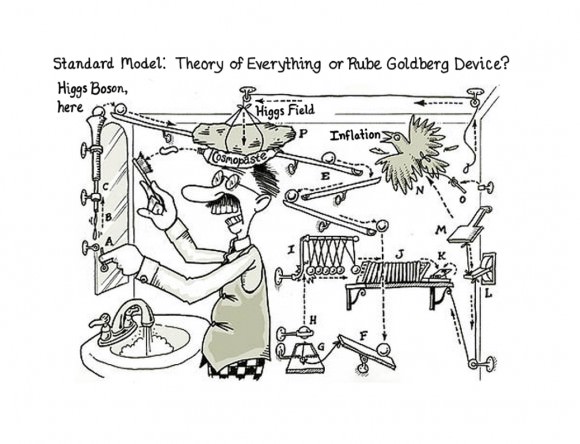
For Higgs and Englert, the reversal of the discovery is by no means the ruination of a life’s work or would be the dismissal of a Nobel Prize. The theoretical work of the physicists have long been recognized by previous awards. The Standard Model as, at least, a partial solution of the theory of everything is like a jig-saw puzzle. Piece by piece is how it is being developed but not without missteps. Furthermore, the pieces added to the Standard Model can be like a house of cards and require replacing a larger solution with a wholly other one. This could be the case of Higgs and Technicolor.
At times like children somewhat determined, physicists thrust a solution into the unfolding puzzle that seems to fit but ultimately has to be retracted. The present discourse does not yet warrant a retraction. Elegance and simplicity is the ultimate characteristics sought in theoretical solutions. Particle physicists also use the term Naturalness when describing the concerns with gauge theory parameters. The solutions – the pieces – of the puzzle created by Peter Higgs and François Englert have spearheaded and encouraged further work which will achieve a sounder Standard Model but few if any claim that it will emerge as the theory of everything.
References:
Pre-print of Technicolor Higgs boson in the light of LHC data
An Introduction to Technicolor, P. Sikivie, CERN, October 1980
First Precise Measurement of Antihydrogen
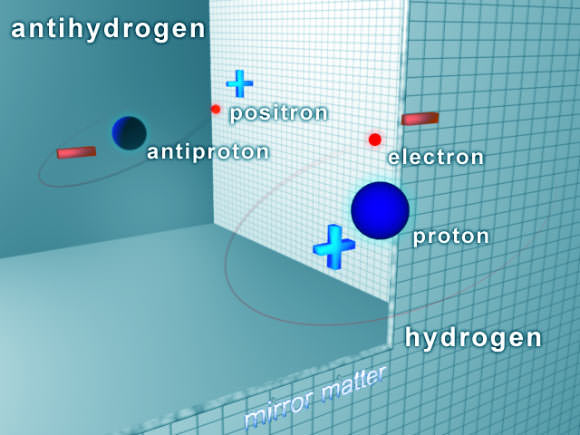
The best science — the questions that capture and compel any human being — is enshrouded in mystery. Here’s an example: scientists expect that matter and antimatter were created in equal quantities shortly after the Big Bang. If this had been the case, the two types of particles would have annihilated each other, leaving a Universe permeated by energy.
As our existence attests, that did not happen. In fact, nature seems to have a one-part in 10 billion preference for matter over antimatter. It’s one of the greatest mysteries in modern physics.
But the Large Hadron Collider is working hard, literally pushing matter to the limit, to solve this captivating mystery. This week, CERN created a beam of antihydrogen atoms, allowing scientists to take precise measurements of this elusive antimatter for the first time.
Antiparticles are identical to matter particles except for the sign of their electric charge. So while hydrogen consists of a positively charged proton orbited by a negatively charged electron, antihydrogen consists of a negatively charged antiproton orbited by a positively charged anti-electron, or a positron
While primordial antimatter has never been observed in the Universe, it’s possible to create antihydrogen in a particle accelerator by mixing positrons and low energy antiprotons.
In 2010, the ALPHA team captured and held atoms of antihydrogen for the first time. Now the team has successfully created a beam of antihydrogen particles. In a paper published this week in Nature Communications, the ALPHA team reports the detection of 80 antihydrogen atoms 2.7 meters downstream from their production.
“This is the first time we have been able to study antihydrogen with some precision,” said ALPHA spokesperson Jeffrey Hangst in a press release. “We are optimistic that ALPHA’s trapping technique will yield many such insights in the future.”
One of the key challenges is keeping antihydrogen away from ordinary matter, so that the two don’t annihilate each other. To do so, most experiments use magnetic fields to trap antihydrogen atoms long enough to study them.
However, the strong magnetic fields degrade the spectroscopic properties of the antihydrogen atoms, so the ALPHA team had to develop an innovative set-up to transfer antihydrogen atoms to a region where they could be studied, far from the strong magnetic field.
To measure the charge of antihydrogen, the ALPHA team studied the trajectories of antihydrogen atoms released from the trap in the presence of an electric field. If the antihydrogen atoms had an electric charge, the field would deflect them, whereas neutral atoms would be undeflected.
The result, based on 386 recorded events, gives a value of the antihydrogen electric charge at -1.3 x 10-8. In other words, its charge is compatible with zero to eight decimal places. Although this result comes as no surprise, since hydrogen atoms are electrically neutral, it is the first time that the charge of an antiatom has been measured to such high precision.
In the future, any detectable difference between matter and antimatter could help solve one of the greatest mysteries in modern physics, opening up a window into a new realm of science.
The paper has been published in Nature Communications.
How CERN’s Discovery of Exotic Particles May Affect Astrophysics
You may have heard that CERN announced the discovery (confirmation, actually. See addendum below.) of a strange particle known as Z(4430). A paper summarizing the results has been published on the physics arxiv, which is a repository for preprint (not yet peer reviewed) physics papers. The new particle is about 4 times more massive than a proton, has a negative charge, and appears to be a theoretical particle known as a tetraquark. The results are still young, but if this discovery holds up it could have implications for our understanding of neutron stars.
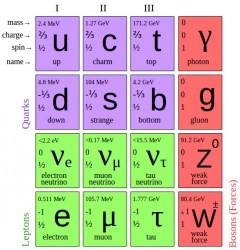
Credit: Wikipedia
The building blocks of matter are made of leptons (such as the electron and neutrinos) and quarks (which make up protons, neutrons, and other particles). Quarks are very different from other particles in that they have an electric charge that is 1/3 or 2/3 that of the electron and proton. They also possess a different kind of “charge” known as color. Just as electric charges interact through an electromagnetic force, color charges interact through the strong nuclear force. It is the color charge of quarks that works to hold the nuclei of atoms together. Color charge is much more complex than electric charge. With electric charge there is simply positive (+) and its opposite, negative (-). With color, there are three types (red, green, and blue) and their opposites (anti-red, anti-green, and anti-blue).
Because of the way the strong force works, we can never observe a free quark. The strong force requires that quarks always group together to form a particle that is color neutral. For example, a proton consists of three quarks (two up and one down), where each quark is a different color. With visible light, adding red, green and blue light gives you white light, which is colorless. In the same way, combining a red, green and blue quark gives you a particle which is color neutral. This similarity to the color properties of light is why quark charge is named after colors.
Combining a quark of each color into groups of three is one way to create a color neutral particle, and these are known as baryons. Protons and neutrons are the most common baryons. Another way to combine quarks is to pair a quark of a particular color with a quark of its anti-color. For example, a green quark and an anti-green quark could combine to form a color neutral particle. These two-quark particles are known as mesons, and were first discovered in 1947. For example, the positively charged pion consists of an up quark and an antiparticle down quark.
Under the rules of the strong force, there are other ways quarks could combine to form a neutral particle. One of these, the tetraquark, combines four quarks, where two particles have a particular color and the other two have the corresponding anti-colors. Others, such as the pentaquark (3 colors + a color anti-color pair) and the hexaquark (3 colors + 3 anti-colors) have been proposed. But so far all of these have been hypothetical. While such particles would be color neutral, it is also possible that they aren’t stable and would simply decay into baryons and mesons.
There has been some experimental hints of tetraquarks, but this latest result is the strongest evidence of 4 quarks forming a color neutral particle. This means that quarks can combine in much more complex ways than we originally expected, and this has implications for the internal structure of neutron stars.
Very simply, the traditional model of a neutron star is that it is made of neutrons. Neutrons consist of three quarks (two down and one up), but it is generally thought that particle interactions within a neutron star are interactions between neutrons. With the existence of tetraquarks, it is possible for neutrons within the core to interact strongly enough to create tetraquarks. This could even lead to the production of pentaquarks and hexaquarks, or even that quarks could interact individually without being bound into color neutral particles. This would produce a hypothetical object known as a quark star.
This is all hypothetical at this point, but verified evidence of tetraquarks will force astrophysicists to reexamine some the assumptions we have about the interiors of neutron stars.
Addendum: It has been pointed out that CERN’s results are not an original discovery, but rather a confirmation of earlier results by the Belle Collaboration. The Belle results can be found in a 2008 paper in Physical Review Letters, as well as a 2013 paper in Physical Review D. So credit where credit is due.
NOvA Experiment Nabs Its First Neutrinos
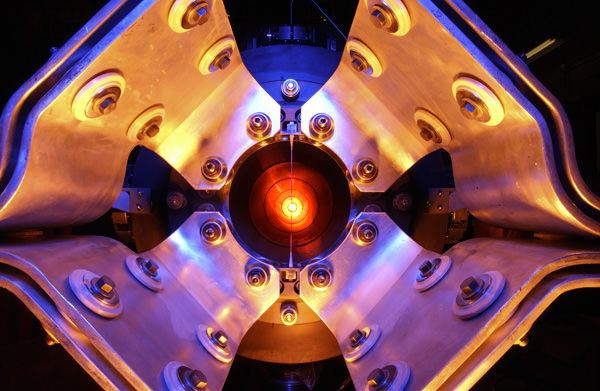
Neutrinos are some of the most abundant, curious, and elusive critters in particle physics. Incredibly lightweight — nigh massless, according to the Standard Model — as well as chargeless, they zip around the Universe at the speed of light and they don’t interact with any other particles. Some of them have been around since the Big Bang and, just as you’ve read this, trillions of them have passed through your body (and more are on the way.) But despite their ubiquitousness neutrinos are notoriously difficult to study precisely because they ignore pretty much everything made out of anything else. So it’s not surprising that weighing a neutrino isn’t as simple as politely asking one to step on a scale.
Thankfully particle physicists are a tenacious lot, including the ones at the U.S. Department of Energy’s Fermilab, and they aren’t giving up on their latest neutrino safari: the NuMI Off-Axis Electron Neutrino Appearance experiment, or NOvA. (Scientists represent neutrinos with the Greek letter nu, or v.) It’s a very small-game hunt to catch neutrinos on the fly, and it uses some very big equipment to do the job. And it’s already captured its first neutrinos — even before their setup is fully complete.
Created by smashing protons against graphite targets in Fermilab’s facility just outside Chicago, Illinois, resulting neutrinos are collected and shot out in a beam 500 miles northwest to the NOvA far detector in Ash River, Minnesota, located along the Canadian border. The very first beams were fired in Sept. 2013, while the Ash River facility was still under construction.

“That the first neutrinos have been detected even before the NOvA far detector installation is complete is a real tribute to everyone involved,” said University of Minnesota physicist Marvin Marshak, Ash River Laboratory director. “This early result suggests that the NOvA collaboration will make important contributions to our knowledge of these particles in the not so distant future.”
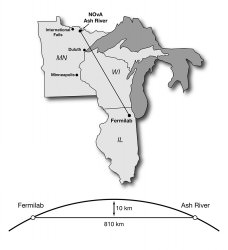
The beams from Fermilab are fired in two-second intervals, each sending billions of neutrinos directly toward the detectors. The near detector at Fermilab confirms the initial “flavor” of neutrinos in the beam, and the much larger far detector then determines if the neutrinos have changed during their three-millisecond underground interstate journey.
Again, because neutrinos don’t readily interact with ordinary particles, the beams can easily travel straight through the ground between the facilities — despite the curvature of the Earth. In fact the beam, which starts out 150 feet (45 meters) below ground near Chicago, eventually passes over 6 miles (10 km) deep during its trip.
According to a press release from Fermilab, neutrinos “come in three types, called flavors (electron, muon, or tau), and change between them as they travel. The two detectors of the NOvA experiment are placed so far apart to give the neutrinos the time to oscillate from one flavor to another while traveling at nearly the speed of light. Even though only a fraction of the experiment’s larger detector, called the far detector, is fully built, filled with scintillator and wired with electronics at this point, the experiment has already used it to record signals from its first neutrinos.”
The 50-foot (15 m) tall detector blocks are filled with a liquid scintillator that’s made of 95% mineral oil and 5% liquid hydrocarbon called pseudocumene, which is toxic but “imperative to the neutrino-detecting process.” The mixture magnifies any light that hits it, allowing the neutrino strikes to be more easily detected and measured. (Source)
“NOvA represents a new generation of neutrino experiments,” said Fermilab Director Nigel Lockyer. “We are proud to reach this important milestone on our way to learning more about these fundamental particles.”
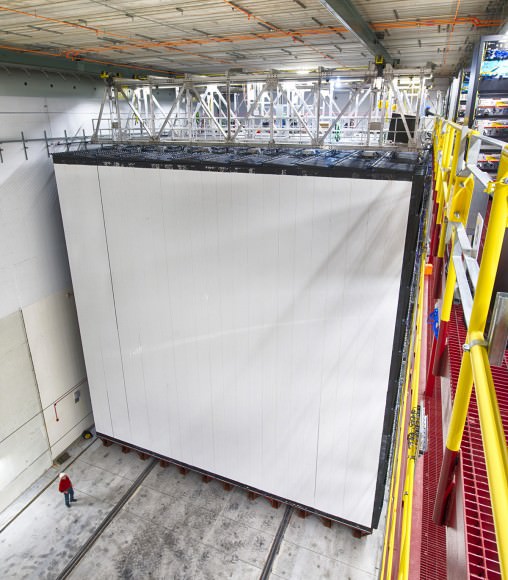
After completion this summer NOvA’s near and far detectors will weigh 300 and 14,000 tons, respectively.
The goal of the NOvA experiment is to successfully capture and measure the masses of the different neutrino flavors and also determine if neutrinos are their own antiparticles (they could be the same, since they lack specific charge.) By comparing the oscillations (i.e., flavor changes) of muon neutrino beams vs. muon antineutrino beams fired from Fermilab, scientists hope to determine their mass hierarchy — and ultimately discover why the Universe currently contains much more matter than antimatter.
Read more: Neutrino Detection Could Help Paint an Entirely New Picture of the Universe
Once the experiment is fully operational scientists expect to catch a precious few neutrinos every day — about 5,000 total over the course of its six-year run. Until then, they at least now have their first few on the books.
“Seeing neutrinos in the first modules of the detector in Minnesota is a major milestone. Now we can start doing physics.”
– Rick Tesarek, Fermilab physicist
Learn more about the development and construction of the NoVA experiment below:
(Video credit: Fermilab)
Find out more about the NOvA research goals here.
Source: Fermilab press release
The NOvA collaboration is made up of 208 scientists from 38 institutions in the United States, Brazil, the Czech Republic, Greece, India, Russia and the United Kingdom. The experiment receives funding from the U.S. Department of Energy, the National Science Foundation and other funding agencies.
Space Station Detector Finds Extra Antimatter in Space, Maybe Dark Matter

The first results from the largest and most complex scientific instrument on board the International Space Station has provided tantalizing hints of nature’s best-kept particle secrets, but a definitive signal for dark matter remains elusive. While the AMS has spotted millions of particles of antimatter – with an anomalous spike in positrons — the researchers can’t yet rule out other explanations, such as nearby pulsars.
“These observations show the existence of new physical phenomena,” said AMS principal investigator Samuel Ting,” and whether from a particle physics or astrophysical origin requires more data. Over the coming months, AMS will be able to tell us conclusively whether these positrons are a signal for dark matter, or whether they have some other origin.”
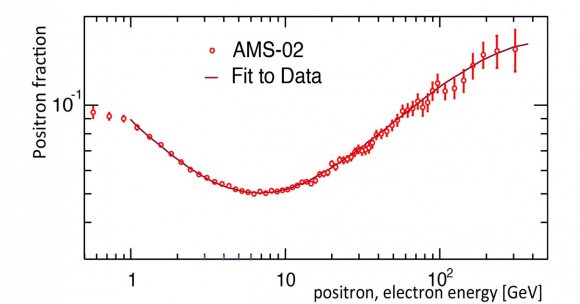
The AMS was brought to the ISS in 2011 during the final flight of space shuttle Endeavour, the penultimate shuttle flight. The $2 billion experiment examines ten thousand cosmic-ray hits every minute, searching for clues into the fundamental nature of matter.
During the first 18 months of operation, the AMS collected of 25 billion events. It found an anomalous excess of positrons in the cosmic ray flux — 6.8 million are electrons or their antimatter counterpart, positrons.
The AMS found the ratio of positrons to electrons goes up at energies between 10 and 350 gigaelectronvolts, but Ting and his team said the rise is not sharp enough to conclusively attribute it to dark matter collisions. But they also found that the signal looks the same across all space, which would be expected if the signal was due to dark matter – the mysterious stuff that is thought to hold galaxies together and give the Universe its structure.
Additionally, the energies of these positrons suggest they might have been created when particles of dark matter collided and destroyed each other.
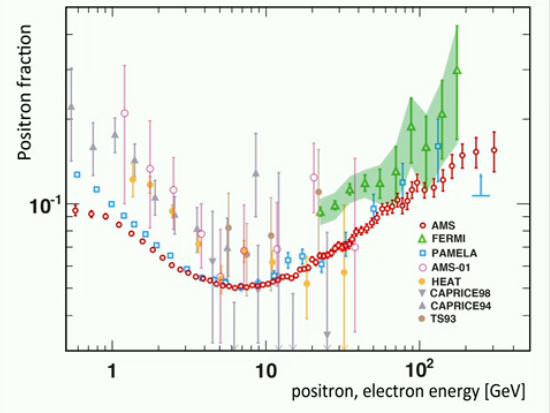
The AMS results are consistent with the findings of previous telescopes, like the Fermi and PAMELA gamma-ray instruments, which also saw a similar rise, but Ting said the AMS results are more precise.
The results released today do not include the last 3 months of data, which have not yet been processed.
“As the most precise measurement of the cosmic ray positron flux to date, these results show clearly the power and capabilities of the AMS detector,” Ting said.
Cosmic rays are charged high-energy particles that permeate space. An excess of antimatter within the cosmic ray flux was first observed around two decades ago. The origin of the excess, however, remains unexplained. One possibility, predicted by a theory known as supersymmetry, is that positrons could be produced when two particles of dark matter collide and annihilate. Ting said that over the coming years, AMS will further refine the measurement’s precision, and clarify the behavior of the positron fraction at energies above 250 GeV.
Although having the AMS in space and away from Earth’s atmosphere – allowing the instruments to receive a constant barrage of high-energy particles — during the press briefing, Ting explained the difficulties of operating the AMS in space. “You can’t send a student to go out and fix it,” he quipped, but also added that the ISS’s solar arrays and the departure and arrival of the various spacecraft can have an effect on thermal fluctuations the sensitive equipment might detect. “You need to monitor and correct the data constantly or you are not getting accurate results,” he said.
Despite recording over 30 billion cosmic rays since AMS-2 was installed on the International Space Station in 2011, the Ting said the findings released today are based on only 10% of the readings the instrument will deliver over its lifetime.
Asked how much time he needs to explore the anomalous readings, Ting just said, “Slowly.” However, Ting will reportedly provide an update in July at the International Cosmic Ray Conference.
More info: CERN press release, the team’s paper: First Result from the Alpha Magnetic Spectrometer on the International Space Station: Precision Measurement of the Positron Fraction in Primary Cosmic Rays of 0.5–350 GeV

